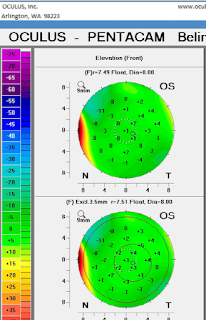My hypothesis is that the longer you leave a pterygium in the eye (ie, do not have it removed) the more likely it will destroy the meibomian glands that rub against hours on end per day. Also, I hypothesize that if you have meibomian gland loss locally and a small eye growth, the loss of meibum oil from the meibomian glands will lead to a greater growth in the pterygium.
Here is an example of a 34 year old Hispanic Male with a nasal pterygium (by his nose: he is looking to his left in this photo below).
His pentacam (which shows the effect of astigmatism) is picking up the induced astigmatism, noted by the red line on the round green image below.
HERE is the meibography of the right eye that does not have a pterygium.
HERE is the meibography of the left eye: He has lost glands right over the area where the pterygium sits on the nasal aspect of the eye (he is looking to his right so you cannot see the pterygium at the same time, but I am seeing many patients like this so will try to post more examples soon.)






